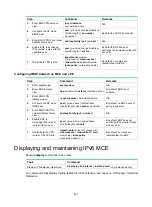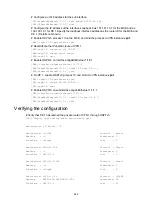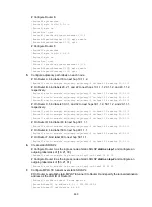
545
Figure 140 How a static SRLSP forwards a packet (adjacency method)
Protocols and standards
•
draft-ietf-spring-segment-routing-mpls-00
•
draft-ietf-spring-segment-routing-02
Static SR over MPLS configuration task list
To configure static SR over MPLS, perform the following tasks:
1.
Enable MPLS TE on all nodes and enable MPLS on all interfaces that will participate in MPLS
TE forwarding.
2.
Configure adjacency information on all nodes that the SRLSP might traverse.
3.
Create a static SRLSP on the ingress node of the MPLS TE tunnel.
4.
Create a tunnel interface on the ingress node of the MPLS TE tunnel, and specify the tunnel
destination address.
5.
On the ingress node of the MPLS TE tunnel, bind the created static SRLSP to the MPLS TE
tunnel interface.
6.
On the ingress node of the MPLS TE tunnel, configure static routing or PBR to direct traffic to
the MPLS TE tunnel.
For information about configuring MPLS TE, see "Configuring MPLS TE." For information about
configuring MPLS, see "Configuring basic MPLS."
The following table lists the SRLSP-specific tasks:
Tasks at a glance
Remarks
(Required.) Configuring an adjacency path
Perform this task on all nodes that a static
SRLSP might traverse.
(Required.) Configuring a static SRLSP
Perform this task only on the ingress node of a
static SRLSP.
(Required.) Binding a static SRLSP to an MPLS TE
tunnel interface
Perform this task only on the ingress node of a
static SRLSP.
Prerequisites
Before you configure static SR over MPLS, perform the following tasks:
•
Determine the ingress node, transit nodes, and egress node of a static LSP.
















































